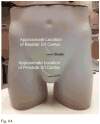Improved performance of prostate DCE-MRI using a 32-coil vs. 12-coil receiver array
- PMID: 28132859
- PMCID: PMC5410393
- DOI: 10.1016/j.mri.2017.01.017
Improved performance of prostate DCE-MRI using a 32-coil vs. 12-coil receiver array
Abstract
Purpose: To assess whether acquisition with 32 receiver coils rather than the vendor-recommended 12 coils provides significantly improved performance in 3D dynamic contrast-enhanced MRI (DCE-MRI) of the prostate.
Materials: The study was approved by the institutional review board and was compliant with HIPAA. 50 consecutive male patients in whom prostate MRI was clinically indicated were prospectively imaged in March 2015 with an accelerated DCE-MRI sequence in which image reconstruction was performed using 12 and 32 coil elements. The two reconstructions were compared quantitatively and qualitatively. The first was done using signal-to-noise ratio (SNR) and g-factor analysis to assess sensitivity to acceleration. The second was done using a five-point scale by two experienced radiologists using criteria of perceived SNR, artifact, sharpness, and overall preference. Significance was assessed with the Wilcoxon signed rank test. Extension to T2-weighted spin-echo and diffusion sequences was assessed in phantom studies.
Results: Reconstruction using 32 vs. 12 coil elements provided improved performance in DCE-MRI based on intrinsic SNR (18% higher) and g-factor statistics (14% higher), with a median 32% higher overall SNR within the prostate volume over all subjects. Reconstruction using 32 coils was qualitatively rated significantly improved (p<0.001) vs. 12 coils on the basis of perceived SNR and radiologist preference and equivalent for sharpness and artifact. Phantom studies suggested the improvement in intrinsic SNR could extend to T2-weighted spin-echo and diffusion sequences.
Conclusions: Reconstruction of 3D accelerated DCE-MRI studies of the prostate using 32 independent receiver coils provides improved overall performance vs. using 12 coils.
Keywords: DCE-MRI; Multi-element receiver coil; Prostate MRI.
Copyright © 2017 Elsevier Inc. All rights reserved.
Figures












Similar articles
-
Application of high-density 2D receiver coil arrays for improved SNR in prostate MRI.Magn Reson Med. 2025 Feb;93(2):850-863. doi: 10.1002/mrm.30289. Epub 2024 Sep 25. Magn Reson Med. 2025. PMID: 39322985
-
Does a cleansing enema improve image quality of 3T surface coil multiparametric prostate MRI?J Magn Reson Imaging. 2015 Sep;42(3):689-97. doi: 10.1002/jmri.24833. Epub 2014 Dec 30. J Magn Reson Imaging. 2015. PMID: 25556957
-
Clinical comparison between a currently available single-loop and an investigational dual-channel endorectal receive coil for prostate magnetic resonance imaging: a feasibility study at 1.5 and 3 T.Invest Radiol. 2014 Jan;49(1):15-22. doi: 10.1097/RLI.0b013e3182a56678. Invest Radiol. 2014. PMID: 24019020
-
Prostate MRI: Is Endorectal Coil Necessary?-A Review.Life (Basel). 2022 Apr 11;12(4):569. doi: 10.3390/life12040569. Life (Basel). 2022. PMID: 35455060 Free PMC article. Review.
-
Artifacts by Misalignment of Cardiac Magnetic Resonance Phased-array Coil Elements: From Simulation to In vivo Test.Curr Med Imaging Rev. 2019;15(3):301-307. doi: 10.2174/1573405613666171024150250. Curr Med Imaging Rev. 2019. PMID: 31989881 Review.
Cited by
-
Determining the optimal magnetic resonance imaging sequences for the efficient diagnosis of temporomandibular joint disorders.Quant Imaging Med Surg. 2021 Apr;11(4):1343-1353. doi: 10.21037/qims-20-67. Quant Imaging Med Surg. 2021. PMID: 33816173 Free PMC article.
-
Technical Aspects of Contrast-enhanced MR Angiography: Current Status and New Applications.Magn Reson Med Sci. 2018 Jan 10;17(1):3-12. doi: 10.2463/mrms.rev.2017-0053. Epub 2017 Aug 31. Magn Reson Med Sci. 2018. PMID: 28855470 Free PMC article.
-
Impact of different phased-array coils on the quality of prostate magnetic resonance images.Eur J Radiol Open. 2021 Feb 3;8:100327. doi: 10.1016/j.ejro.2021.100327. eCollection 2021. Eur J Radiol Open. 2021. PMID: 33644263 Free PMC article.
References
-
- Delongchamps NB, Rouanne M, Flam T, et al. Multiparametric magnetic resonance imaging for the detection and localization of prostate cancer: combination of T2-weighted, dynamic contrast-enhanced and diffusion-weighted imaging. BJU International. 2010;107:1411–8. - PubMed
-
- Dickinson L, Ahmed HU, Allen C, et al. Magnetic resonance imaging for the detection, localization, and characterization of prostate cancer: recommendations from a European consensus meeting. Eur Urology. 2011;59:477–94. - PubMed
-
- Franiel T, Hamm B, Hricak H. Dynamic contrast-enhanced magnetic resonance imaging and pharmacokinetic models in prostate cancer. Eur Radiol. 2011;21:616–26. - PubMed
MeSH terms
Grants and funding
LinkOut - more resources
Full Text Sources
Other Literature Sources
Medical

